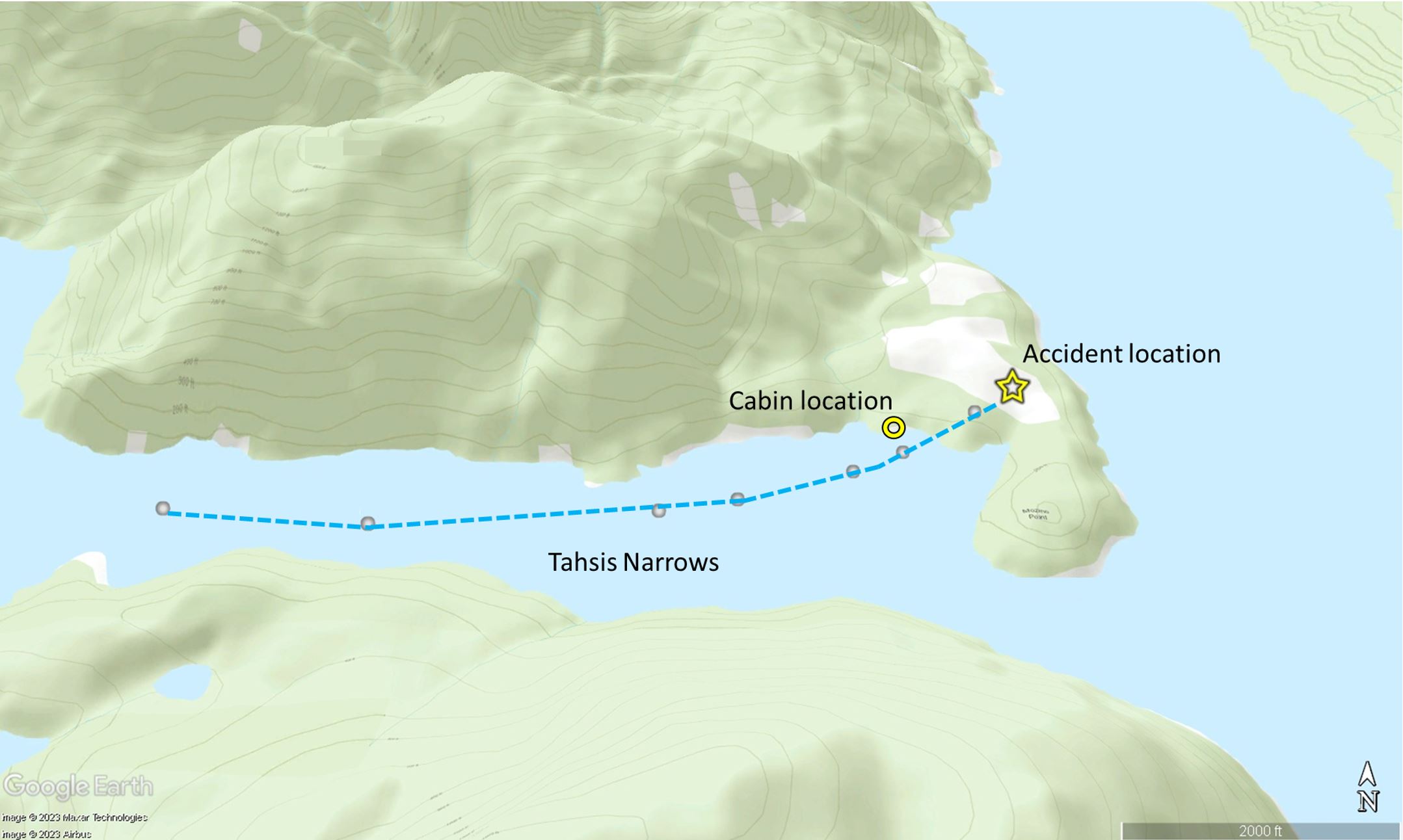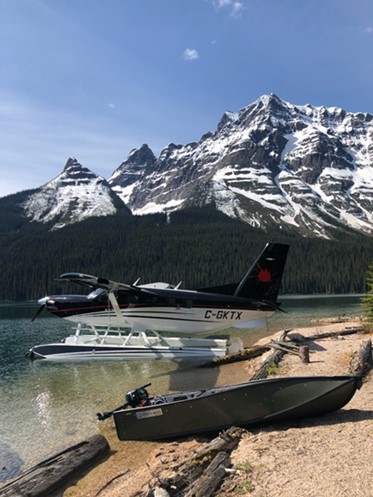Collision with terrain
Privately registered
Quest Kodiak 100, C-GKTX
Tofino/Long Beach Airport, British Columbia, 60 NM NW
The Transportation Safety Board of Canada (TSB) investigated this occurrence for the purpose of advancing transportation safety. It is not the function of the Board to assign fault or determine civil or criminal liability. This report is not created for use in the context of legal, disciplinary or other proceedings. See Ownership and use of content. Masculine pronouns and position titles may be used to signify all genders to comply with the Canadian Transportation Accident Investigation and Safety Board Act (S.C. 1989, c. 3).
History of the flight
At 1121Footnote 1 on 20 June 2023, the privately registered Quest Kodiak 100 amphibious float-equipped aircraft (registration C-GKTX, serial number 100-0010) departed Masset Airport (CZMT), British Columbia (BC), on an instrument flight rules (IFR) flight to Tofino/Long Beach Airport (CYAZ), BC, with 1 pilot and 3 passengers on board.
While enroute, at 1246, the pilot contacted air traffic control to cancel IFR and continued the flight under visual flight rules (VFR). The aircraft continued the flight to the planned final destination, which was a cabin approximately 60 nautical miles northwest of CYAZ.
The aircraft followed an inlet (Tahsis Narrows) toward the destination and continued for a straight-in landing on the water, near the cabin (Figure 1).
On initial touchdown, both floats touched the surface of the water simultaneously. The aircraft bounced and, as the aircraft approached the surface of the landing area the 2nd time in a level attitude, the left float reportedly made contact with either a boat wake or object.Footnote 2 The force of the contact resulted in the aircraft bouncing to a height of approximately 30 feet and banking to the right.
The pilot initiated a go-around. At 1337, during the initial climb over land, the aircraft contacted trees and then impacted the terrain.
The pilot and 1 passenger were fatally injured, 1 passenger received serious injuries, and 1 passenger received minor injuries. There was a post-impact fire. The aircraft was destroyed.
The emergency locator transmitter signal was received by the Joint Rescue Coordination Centre in Victoria, BC. The Canadian Coast Guard, Canadian Armed Forces search and rescue, the RCMP (Royal Canadian Mounted Police), and fire personnel responded.
Pilot information
The pilot held a private pilot licence – aeroplane, valid for all single-pilot, non-high performance, single- and multi-engine, land and sea planes. The licence was endorsed for both night and VFR over-the-top flying. The pilot also held a Group 1 instrument rating and his Category 3 medical certificate was valid. He had accumulated approximately 1200 total flight hours. The pilot held the appropriate licence for the flight in accordance with existing regulations.
The pilot had approximately 250 flight hours on the occurrence amphibious aircraft, with about half of the landings on water. Most of the pilot’s water-based takeoff and landing experience occurred on lakes rather than the ocean.
The pilot had landed once before at this location, 5 days before the occurrence.
According to information gathered during the investigation, there was no indication that the pilot’s performance was affected by medical or physiological factors.
Weather information
The nearest airport to the accident site with weather reporting was CYAZ. At 1300, the aerodrome routine meteorological report was as follows:
- Winds from 170° true at 7 knots
- Visibility of 15 statute miles
- Broken ceiling at 2600 feet above ground level (AGL)
- Temperature 15 °C, dew point 11 °C
- Altimeter setting 30.16 inches of mercury
The aerodrome forecast issued at 1140 indicated that conditions at CYAZ at the time of the occurrence would be:
- Winds from 170° true at 8 knots
- Visibility greater than 6 statute miles
- Scattered clouds at 700 feet AGL and broken ceiling at 2000 feet AGL
Based on a review of the imagery available, it was determined that the wind was from 4 to 6 knots and the sea had small waves at the time of the occurrence.
Wind shear and downdrafts
The Transport Canada Aeronautical Information Manual defines wind shear as a “change in wind speed and/or wind direction in a short distance.”Footnote 3 It notes that wind shear “can exist in a horizontal or vertical direction and occasionally in both.”Footnote 4 When wind is forced over a mountain range, waves may form on the lee side of the mountains. These lee waves produce prominent downdrafts close to the mountain.
Although the exact winds at the time of the occurrence are unknown, winds in mountain ranges can be very unpredictable and downdraftsFootnote 5 are not uncommon. As explained in Mountain Flying,
[w]hen wind blows over large mountain ridges, the wind blowing up the windward slope, in a stable atmosphere, is usually relatively smooth. However, it spills rapidly down the leeward side, setting up strong downdrafts and causing turbulence in a situation which can be compared to water flowing down a rough stream bed. These downdrafts may be dangerous and can place an aircraft in a position from which it might not able to recover.Footnote 6
In addition, as explained in Weather Ways, “[i]n general, the strength of the downdrafts is such that an aircraft flying parallel to the range could be forced to the ground or, if flying upwind, might fail to clear the range.”Footnote 7
There was no weather information for the occurrence location; however, due to the mountainous terrain, it is possible that wind shear and/or downdrafts were present in the area at the time of the accident.
Aircraft information
The Quest Kodiak 100 is a high-wing, single-engine turbine aircraft (Figure 2). The occurrence aircraft was manufactured in 2009. It was equipped with Aerocet Twin 6650 amphibious floats and powered by a Pratt & Whitney PT6A-34 engine.
The investigation did not identify any issues related to the aircraft’s equipment or maintenance that would have prevented it from operating normally during the occurrence flight.
Aircraft performance
A rejected landing is a manoeuvre that is normally initiated when the aircraft is at low height above the ground, and usually results in a go-around. When the reason for the rejected landing is related to aircraft configuration or performance, it is sometimes called a balked landing.
The procedure for a balked landing found in the float manufacturer’s Airplane Flight Manual Supplement is as follows:
BALKED LANDING
1. RETRACT FLAPS TO 20° IMMEDIATELY AFTER APPLYING TAKEOFF POWER FOR GO-AROUND. AIRSPEED TO 74 KIAS.Footnote 8
Impact and wreckage information
The aircraft struck trees and impacted the terrain in an upright position and on its right side. A post-impact fire began and the aircraft was destroyed. The floats and wings had detached from the fuselage. The flaps were extended to 20°.
Owing to damage from the fire, the TSB was unable to determine the engine control position or condition of the floats. The propeller blade damage was consistent with the engine producing power at the time of impact. The wheels were retracted.
Approach to landing on water
Transport Canada has provided the following arrival recommendations for floatplane pilots:
When you’re ready to land, circle at least 3 times in order to:
- Assess the wind strength and direction
- Check the landing run area for floating obstacles, submerged deadheads and boaters
- Check the approach for obstructions, including trees, buildings and wires (usually between islands and the mainland)
- Check the departure area for obstructions
- Remember that landing distance doesn’t guarantee enough takeoff distance
- Know your glassy water proceduresFootnote 9
Guidance from the Federal Aviation Administration (FAA) of the United States recommends that:
It is usually a good practice to circle the area of intended landing and examine it thoroughly for obstructions such as pilings or floating debris, and to note the direction of movement of any boats that may be in or moving toward the intended landing site.Footnote 10
The FAA further recommends that:
Evaluation of the landing area should include approach and departure paths. Terrain that rises faster than the seaplane can climb is an obvious consideration, both for the eventual takeoff as well as in case of a go-around during landing. If climbout over the terrain is not easily within the seaplane’s capabilities, be certain there is sufficient room to make a gentle turn back over the water for climb.
GO-AROUND
Whenever landing conditions are not satisfactory, execute a go-around. […] Climb to a safe altitude while executing the go-around checklist, then evaluate the situation, and make another approach under more favorable conditions. Remember that it is often best to make a gentle climbing turn back over the water to gain altitude, rather than climbing out over a shoreline with rising terrain or noise-sensitive areas.Footnote 11
TSB laboratory reports
The TSB completed the following laboratory report in support of this investigation:
- LP084-2023 – NVM Recovery – Flight Tracker and Foreflight
Safety message
It is important that, before landing, floatplane pilots evaluate their intended landing site for hazards. This includes assessing the area for water surface conditions and potential wind shear and downdrafts; ensuring that both the approach and departure paths are free of obstructions; and considering options in the event of a go-around.
This report concludes the Transportation Safety Board of Canada’s investigation into this occurrence. The Board authorized the release of this report on . It was officially released on .

